Why Kashgar Ancient City Should Be on Every Travel Bucket List
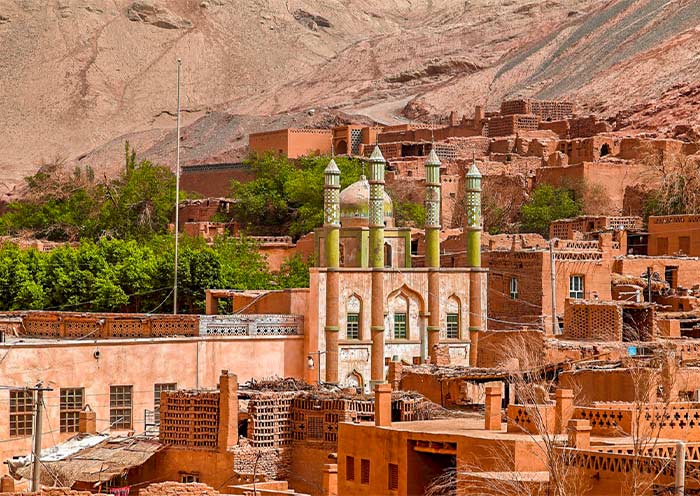
An Essential Guide to Visiting Kashgar Ancient City
Kashgar Ancient City, a gem nestled in the heart of Xinjiang, beckons travelers with its rich tapestry of history, culture, and vibrant local life. As one of the most significant stops along the legendary Silk Road, this historic enclave is an enchanting blend of the old and the new, where narrow alleys wind past mud-brick structures adorned with intricately carved wooden doors, creating an atmosphere that feels both timeless and alive with the pulse of everyday life.
Walking through the streets of Kashgar, you’ll encounter the warm hospitality of the Uyghur people, whose unique customs and traditions are woven into the very fabric of this captivating city. The aroma of sizzling lamb kebabs and the sounds of artisans at work fill the air, inviting you to explore the colorful markets and bustling squares that illustrate the city’s vibrant culture. Despite the renovations aimed at preserving its charm, the spirit of Kashgar remains intact, offering visitors a glimpse into a world where history and modernity coexist in harmony.
Whether you’re wandering through the lively bazaar, sampling local delicacies, or simply soaking in the picturesque views of this ancient city, Kashgar promises an unforgettable experience that will linger in your memory long after you leave. Embrace the adventure that awaits and discover why Kashgar Ancient City is a must-visit destination for any intrepid traveler.
In This Guide
- An Essential Guide to Visiting Kashgar Ancient City
- The Rich History and Legends of Kashgar Ancient City
- Main Highlights: What You Absolutely Can’t Miss
- Planning Your Visit: A Practical Guide
- Tickets: Prices, Booking, and Tips
- How to Get There: A Complete Transportation Guide
- Local Cuisine and Accommodation Nearby
- Frequently Asked Questions
- Final Thoughts on Your Trip
The Rich History and Legends of Kashgar Ancient City
Nestled at the crossroads of the ancient Silk Road, Kashgar Ancient City is a living testament to centuries of cultural fusion and historical significance. Often referred to as the “City of Merchants,” Kashgar has long been a vibrant hub where traders, travelers, and diverse cultures converge. Its storied past is woven into the very fabric of its narrow alleys, bustling bazaars, and intricate mud-brick architecture.
The Historical Tapestry of Kashgar
Kashgar’s history dates back over 2,000 years, making it one of the oldest cities in Xinjiang, China. This ancient city has served as a critical point for trade between the East and the West, facilitating the exchange of silk, spices, and ideas. The strategic location of Kashgar allowed it to thrive as a melting pot of diverse influences—from Central Asian nomads to Persian traders and beyond.
Throughout the centuries, the city has witnessed the rise and fall of empires. Under the rule of the Tang Dynasty, Kashgar flourished as a vital outpost of the Silk Road. It was during this time that the city became a cultural beacon, attracting scholars, artists, and merchants. The advent of Islam in the 8th century transformed Kashgar into a center of Islamic culture and scholarship, with stunning architectural monuments such as the Id Kah Mosque emerging as symbols of its religious significance.
Legends and Lore
Kashgar is steeped in legends that reflect its rich cultural heritage. One popular tale tells of the mystical origins of the city, suggesting that it was founded by a legendary hero who guided traders through treacherous mountain passes. This hero is said to have discovered a hidden oasis that became Kashgar, enabling it to thrive amidst the arid landscapes of Xinjiang.
Another enduring legend is that of the “Seven Star Tombs,” a series of ancient burial sites believed to be the final resting place of noble figures from Kashgar’s past. These tombs are shrouded in mystery, with tales of lost treasures and spirits guarding the secrets of the ancients.
A Modern Transformation
In recent years, Kashgar Ancient City has undergone significant restoration efforts aimed at preserving its historical character while adapting to modern needs. The narrow alleys, traditional timber doors, and mud structures still echo the city’s storied past, offering visitors a glimpse into the life of the Uyghur people—whose vibrant culture remains a cornerstone of Kashgar’s identity.
While some may argue that the renovations have altered the authenticity of the ancient city, many travelers find that the charm of Kashgar lies in its ability to blend the old with the new. Visitors can engage with local artisans, savor traditional Uyghur dishes like lamb kebabs, and experience the daily rhythms of life in this captivating locale.
Embrace the Journey
Exploring Kashgar Ancient City is more than just a visit; it’s a walk through time. As you wander its labyrinthine streets, each turn reveals a new story, a glimpse into the past, and a connection to the present. Whether you’re captivated by the artistry of local crafts or the tantalizing aromas wafting through the air from street vendors, Kashgar invites you to immerse yourself in its rich history and legends. This ancient city, with its vibrant pulse and storied past, will leave an indelible mark on your travel experience.

Kashgar Ancient City.
Main Highlights: What You Absolutely Can’t Miss
Kashgar Ancient City, or Ga Er Ancient City, is a captivating destination that offers a glimpse into the rich tapestry of culture and history along the Silk Road. Here are some of the main highlights that you absolutely cannot miss during your visit:
Winding Alleys and Mud Structures
As you stroll through the narrow alleys of the old town, you’ll find yourself surrounded by charming timber doors and traditional mud-brick houses. These winding paths are not only picturesque but also echo the lively daily life of the residents. Take your time to explore and soak in the atmosphere; you might even catch a glimpse of local artisans at work, showcasing skills that have been passed down through generations.
Id Kah Mosque
One of the most significant religious sites in the region, the Id Kah Mosque is a must-see. This stunning mosque, with its impressive architecture and vibrant courtyard, serves as a spiritual heart for the local Uyghur community. Make sure to respect the customs of the site, and if you’re lucky, you might witness a local prayer session, offering insight into the deep-rooted traditions of this community.
Craftsmanship and Street Food
The ancient city is not just about sights; it’s also a feast for the senses. Visit the various workshops where local craftsmen create intricate handicrafts, from traditional carpets to exquisite jewelry. Afterward, indulge in some mouth-watering street food. The aroma of sizzling lamb kebabs and fresh naan will tempt you at every corner, making it hard to resist trying everything on offer.
Local Markets
Don’t miss the bustling markets that encapsulate the essence of Kashgar. The livestock market is particularly vibrant, showcasing the region’s agricultural heritage. Here, you can witness the colorful exchange between buyers and sellers, all amidst the sounds and scents of local life. It’s an experience that truly immerses you in the culture.
Abakh Hoja Tomb
A short walk from the heart of the ancient city, the Abakh Hoja Tomb is a breathtaking mausoleum adorned with intricate tile work. This site not only serves as a resting place for a prominent Uyghur figure but is also a stunning example of Islamic architecture. The serene ambiance here provides a peaceful contrast to the bustling streets of Kashgar.
Gaotai Ancient Homes
For a deeper understanding of traditional Uyghur life, explore the Gaotai Ancient Homes. Although many structures have been renovated, they still preserve the essence of Kashgar’s rich history. Wander through these historic residences and take in the unique architectural styles that tell stories of the past.
The Atmosphere
Lastly, one of the most enchanting aspects of Kashgar Ancient City is the atmosphere itself. With no vehicles allowed in certain areas, the sounds of children playing, merchants calling out, and the sizzling of street food create a harmonious blend that feels almost timeless. Spend a leisurely day wandering through the labyrinthine streets, and you’ll come away with unforgettable memories and a deeper appreciation of this unique cultural hub.
Kashgar Ancient City is a treasure trove of experiences waiting to be discovered. Whether you are exploring its historical sites, savoring local delicacies, or simply soaking in the vibrant atmosphere, this ancient city promises an adventure unlike any other.
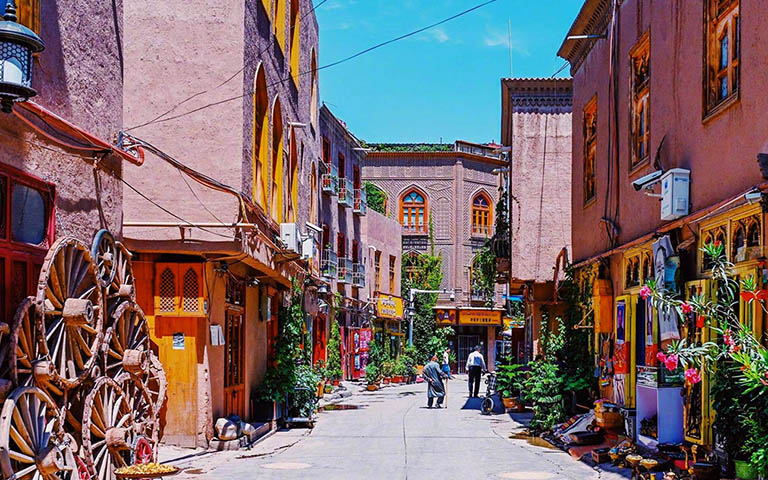
Kashgar Ancient City.
Planning Your Visit: A Practical Guide
Visiting Kashgar Ancient City is like stepping into a vibrant tapestry woven with history, culture, and the lively spirit of the Uyghur people. This guide will help you make the most of your experience in one of China’s most enchanting destinations.
Getting There
Location: Kashgar Ancient City, also known as Ga Er Ancient City, is located in the Xinjiang Uyghur Autonomous Region, in the far west of China. The city is accessible via Kashgar Airport, which has both domestic and limited international flights.
Transportation: Once in Kashgar, you can use local taxis, ride-sharing apps, or public buses to reach the ancient city. The city center is compact and walkable, making it easy to explore on foot.
Best Time to Visit
The ideal time to visit Kashgar is during the spring (April to June) and autumn (September to October) when the weather is mild and pleasant. Summers can be quite hot, while winters may bring cold temperatures.
Entry Requirements
Foreign visitors should ensure they have the necessary visas to enter China. It’s advisable to carry a passport at all times, as local authorities may require identification. Expect to go through security checks when entering the ancient city.
What to Expect
Kashgar Ancient City is a blend of old-world charm and modern restoration efforts. While some structures have been renovated, the ambiance remains steeped in tradition. Visitors can wander through narrow alleys lined with mud-brick buildings, admire timber doors, and soak in the bustling atmosphere of local life.
Key Highlights:
– Craftsmen and Artisans: Watch skilled craftsmen at work, showcasing traditional techniques passed down through generations.
– Street Food: Don’t miss out on trying local specialties like lamb kebabs and other delicious street foods.
– Cultural Experiences: Engage with the local community and experience their vibrant culture.
Tips for Your Visit
- Dress Appropriately: While Kashgar is relatively welcoming, it’s respectful to dress modestly, especially when in the presence of local residents.
- Stay Hydrated: The weather can get hot, so carry water with you as you explore.
- Photography: While photography is generally welcomed, always ask permission before taking pictures of local people.
- Money Matters: Cash is king in the ancient city. ATMs are available, but it’s wise to have cash on hand for street vendors and small shops.
Nearby Attractions
After exploring the ancient city, consider visiting nearby attractions such as:
– Id Kah Mosque: The largest mosque in China, featuring stunning architecture.
– Abakh Hoja Tomb: A beautifully designed mausoleum that reflects the historical significance of the region.
Recommended Tours
If you prefer a guided experience, consider joining one of the many local tours available. Options range from half-day explorations to multi-day packages that include visits to other Xinjiang highlights like Turpan and Urumqi.
Safety and Security
Kashgar is generally safe for tourists, but it’s wise to remain vigilant, especially in crowded areas. The presence of police is noticeable but aimed at ensuring safety.
Final Thoughts
Kashgar Ancient City offers a unique glimpse into the rich tapestry of Uyghur culture and heritage. With its vibrant streets, delicious food, and friendly locals, your visit is sure to be memorable. Embrace the experience, take your time, and allow yourself to be immersed in the magic of this ancient Silk Road city.
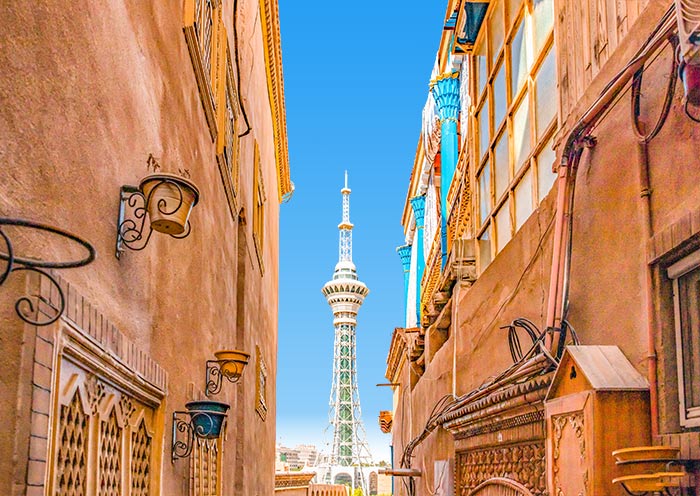
Kashgar Ancient City.
Tickets: Prices, Booking, and Tips
Exploring Kashgar Ancient City, or Ga Er Ancient City, is an unforgettable journey into the heart of one of China’s most culturally rich regions. Here’s everything you need to know about tickets, prices, and booking tips to make the most of your visit.
Ticket Information and Pricing
Visiting Kashgar Ancient City does not require a separate admission fee; instead, it is free to explore the winding alleys, traditional architecture, and bustling markets. However, visitors should be prepared to spend on various experiences within the city, such as:
- Crafts and Souvenirs: Local artisans showcase their skills in the narrow lanes, offering unique handmade goods. Prices can range from a few Yuan for small trinkets to several hundred for intricate pieces.
- Street Food: Indulge in local delicacies such as lamb kebabs, pilaf, and various Uyghur pastries. Expect to pay between 10-50 Yuan for a meal, depending on your choice.
- Cultural Experiences: Some workshops or guided tours might charge a fee, typically around 50-200 Yuan, depending on the length and type of experience.
Booking Tips
-
Plan Your Visit: Aim to explore the city in the morning or late afternoon to avoid the midday heat, especially during the summer months. Early visits also allow you to enjoy a quieter atmosphere before the crowds arrive.
-
Consider Guided Tours: While wandering through the ancient city is a delightful experience in itself, joining a guided tour can enhance your understanding of the rich history and culture. Group tours typically range from 200 to 1,000 Yuan, depending on the duration and inclusions.
-
Free Cancellation: If you opt for a tour or experience, look for options that offer free cancellation to maintain flexibility in your travel plans.
-
Local Currency: Ensure you have sufficient cash in Chinese Yuan, as many small vendors and eateries may not accept credit cards.
-
Stay Connected: Consider purchasing a local SIM card or portable Wi-Fi device to help navigate and stay in touch while exploring the city.
-
Respect Local Customs: As you wander through the ancient city, be mindful of local customs and practices, particularly in residential areas. Engaging with local residents can enrich your experience but always approach with respect and courtesy.
Conclusion
With its vibrant atmosphere and rich history, Kashgar Ancient City is a must-visit destination for any traveler exploring Xinjiang. By keeping these tips in mind, you’ll be well-equipped to make the most of your visit and create lasting memories in this unique corner of China. Enjoy your adventure!
How to Get There: A Complete Transportation Guide
Getting to Kashgar Ancient City is an adventure in itself, as it lies at the intersection of ancient trade routes and modern travel. Here’s a comprehensive guide to help you navigate your way to this fascinating destination in Xinjiang, China.
By Air
Kashgar Airport (KHG) is the primary gateway for international travelers heading to Kashgar. While direct international flights may be limited, you can find connections from major cities in China, such as Urumqi, Beijing, and Shanghai.
- From Kashgar Airport to the City Center:
- Taxi: Taxis are available at the airport, and the ride to the ancient city takes about 30 minutes, costing around 50-100 RMB (approximately $8-$15).
- Airport Shuttle: Check if your accommodation offers shuttle services, as some hotels provide transportation for their guests.
By Train
Kashgar is accessible by train, providing a scenic journey through the region’s rugged landscapes.
- From Urumqi:
-
Take the train from Urumqi Railway Station to Kashgar Railway Station. The journey takes approximately 24 hours, with sleeper options available for comfort. Tickets can be booked online or at the station, and prices vary based on class.
-
From Other Cities:
- There are also train services from other cities in Xinjiang, such as Turpan and Hotan. Be sure to check the schedule in advance, as trains may not run daily.
By Bus
Long-distance buses are another option to reach Kashgar from various cities in Xinjiang.
- From Urumqi:
-
Buses depart frequently from the Urumqi Long-Distance Bus Station. The journey takes around 30 hours, and tickets can be purchased at the station. It’s advisable to book in advance during peak travel seasons.
-
From Nearby Cities:
- Frequent bus services connect Kashgar with several cities in the region, including Aksu, Hotan, and Turpan. These buses are usually comfortable and provide a local experience.
Local Transportation within Kashgar
Once you arrive in Kashgar, getting to the Ancient City is straightforward:
-
Walking: The Ancient City is pedestrian-friendly, with narrow alleyways and charming mud-brick structures awaiting exploration. Strolling through the streets is the best way to absorb the atmosphere.
-
Bicycles and Electric Scooters: Consider renting a bicycle or an electric scooter for a quicker way to traverse the area. Many local shops offer rentals.
-
Taxis and Ride-hailing Apps: Local taxis are available, and you can also use apps like Didi Chuxing to request rides conveniently.
Tips for Your Journey
-
Travel Documents: Ensure you have your passport and any required permits to enter the Xinjiang region, especially for foreign travelers.
-
Language: While Mandarin is widely spoken, having a translation app or a phrasebook can be helpful as English may not be commonly understood.
-
Cash: Not all places accept credit cards, so carry some cash (Chinese Yuan) for street food, local shops, and smaller vendors.
-
Timing: The best time to visit Kashgar is during spring (April to June) and autumn (September to October) when the weather is mild and the streets are less crowded.
With these transportation tips, you’re all set to embark on your journey to Kashgar Ancient City, a place steeped in history and culture that promises a unique travel experience. Safe travels!
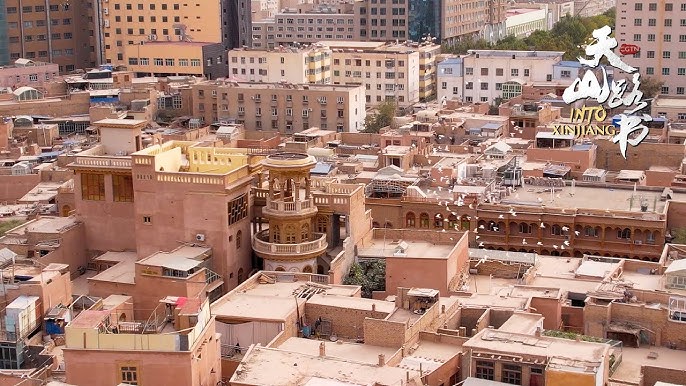
Kashgar Ancient City.
Local Cuisine and Accommodation Nearby
Exploring the vibrant streets of Kashgar Ancient City not only immerses you in the rich tapestry of history but also offers the chance to indulge in a culinary adventure and find comfortable accommodations nearby.
Local Cuisine
Kashgar’s culinary scene is a delightful reflection of the region’s ethnic diversity, mainly influenced by the Uyghur culture. As you wander through the narrow alleys, you’ll encounter a variety of tantalizing street foods and local eateries that capture the essence of Xinjiang’s flavors.
-
Lamb Kebabs (Chuanr): A must-try dish, these skewers of marinated lamb are grilled to perfection and are available from numerous street vendors. Pair them with a sprinkle of cumin for an authentic taste.
-
Naan Bread: This traditional flatbread is a staple in Kashgar. Look for vendors serving freshly baked naan, which complements almost any meal.
-
Dapanji (Big Plate Chicken): Often served in a large dish, this hearty stew combines chicken, potatoes, and fresh vegetables, seasoned with aromatic spices. It’s a perfect dish for sharing.
-
Pilaf (Polo): Made with fragrant rice, tender meat, and an assortment of vegetables, this dish is not only filling but also a staple at local gatherings.
-
Fruits and Nuts: The region is famous for its dried fruits and nuts. Don’t miss the opportunity to sample apricots, raisins, and walnuts from local markets.
Nearby Accommodations
After a day of exploration and culinary delights, you’ll want a comfortable place to rest. Fortunately, there are several accommodations within easy reach of Kashgar Ancient City:
-
Kashgar Pamir Hotel: Located just a short distance from the ancient city, this hotel offers modern amenities with a touch of local decor. Guests rave about the friendly staff and delicious breakfast featuring local dishes.
-
Bishkek Hotel: This mid-range option provides a cozy atmosphere and is well-situated for exploring the old town. The hotel features comfortable rooms and offers guided tours of the city.
-
Kashgar Yutong Hotel: If you’re looking for a budget-friendly option, this hotel is a great choice. It’s clean, comfortable, and offers easy access to local attractions, making it ideal for backpackers.
-
Silk Road Hotel: With its traditional architecture and warm hospitality, this hotel is perfect for those wanting to experience local culture without sacrificing comfort. The on-site restaurant serves a variety of Uyghur dishes.
-
Hostels: For the more adventurous traveler, consider staying at one of the local hostels, such as Kashgar Backpackers Hostel, which provides a communal atmosphere and the chance to meet fellow travelers.
Whether you’re savoring the local dishes or resting in a welcoming hotel, your time in Kashgar Ancient City is sure to be unforgettable.
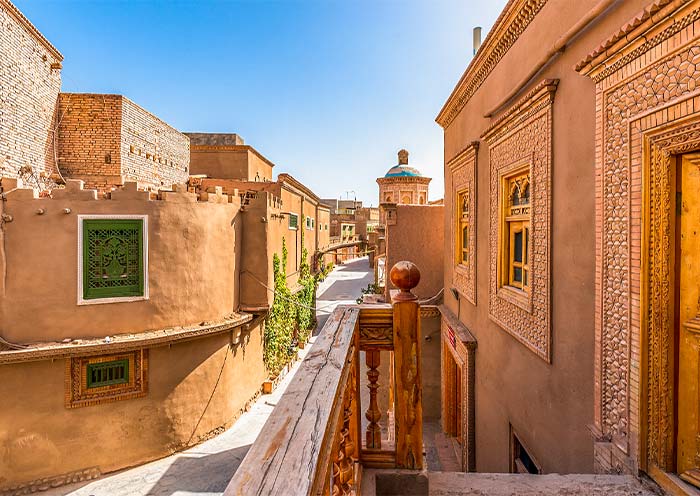
Kashgar Ancient City.
Frequently Asked Questions
-
What is Kashgar Ancient City known for?
Kashgar Ancient City, also known as Ga Er Ancient City, is celebrated for its narrow alleys, traditional mud-brick architecture, and vibrant local culture. It’s a historical hub along the Silk Road, where you can experience Uyghur culture, craftsmanship, and delicious street food. -
How do I get to Kashgar Ancient City?
The Ancient City is located in the heart of Kashgar, easily accessible by walking from major hotels or attractions. If you’re arriving from the airport or train station, taxis are readily available, and public buses can also take you close to the area. -
What are the best times to visit?
The best times to explore Kashgar Ancient City are during the spring (April to June) and autumn (September to November) when the weather is mild. During the summer, temperatures can soar, while winter can be quite cold. -
Is Kashgar Ancient City safe for tourists?
Yes, Kashgar Ancient City is generally safe for tourists. While there is a noticeable police presence, especially at entry points, most visitors report feeling secure. It’s always advisable to stay aware of your surroundings and follow local guidelines. -
What should I wear while visiting?
Dress modestly, respecting the local culture; this is especially important when visiting religious sites. Lightweight, breathable clothing is recommended, as well as comfortable shoes for walking through the uneven cobblestone streets. -
Are there any entry fees for Kashgar Ancient City?
There are no entrance fees to wander through Kashgar Ancient City itself. However, some specific attractions or workshops may charge a small fee for entry or participation. -
What can I expect to find in the Ancient City?
Expect to see stunning architecture, traditional workshops showcasing local craftsmanship, bustling markets, and an array of street food vendors. Don’t miss the chance to try local specialties like lamb kebabs and naan. -
Are guided tours available, and are they recommended?
Yes, guided tours are available and can enhance your experience by providing historical context and local insights. They are especially recommended for first-time visitors to help navigate the area and discover hidden gems.
Final Thoughts on Your Trip
As your journey through the enchanting lanes of Kashgar Ancient City comes to a close, take a moment to reflect on the myriad experiences that have unfolded before you. This vibrant tapestry of culture, history, and daily life offers a glimpse into a world where the past and present coexist harmoniously.
Strolling through the narrow alleys lined with mud-brick structures and intricately carved timber doors, you’ve witnessed the heart and soul of the Uyghur community. The sounds of laughter, the sizzle of street food, and the skillful craftsmanship of local artisans create an atmosphere that is both lively and inviting. Whether you’ve indulged in succulent lamb kebabs or engaged in conversations with friendly locals, each moment adds a unique chapter to your travel story.
Despite the modern renovations that have transformed parts of the Old City, the essence of Kashgar remains unaltered. It is a place where heritage is celebrated, and traditions are cherished, making it a must-visit destination for anyone seeking an authentic experience.
As you prepare to leave this captivating locale, carry with you not just memories of picturesque vistas and delectable dishes, but also a deeper understanding of the rich cultural mosaic that is Kashgar. Let the warmth of its people and the beauty of its streets linger in your heart, inspiring future adventures along the historic Silk Road. Safe travels!